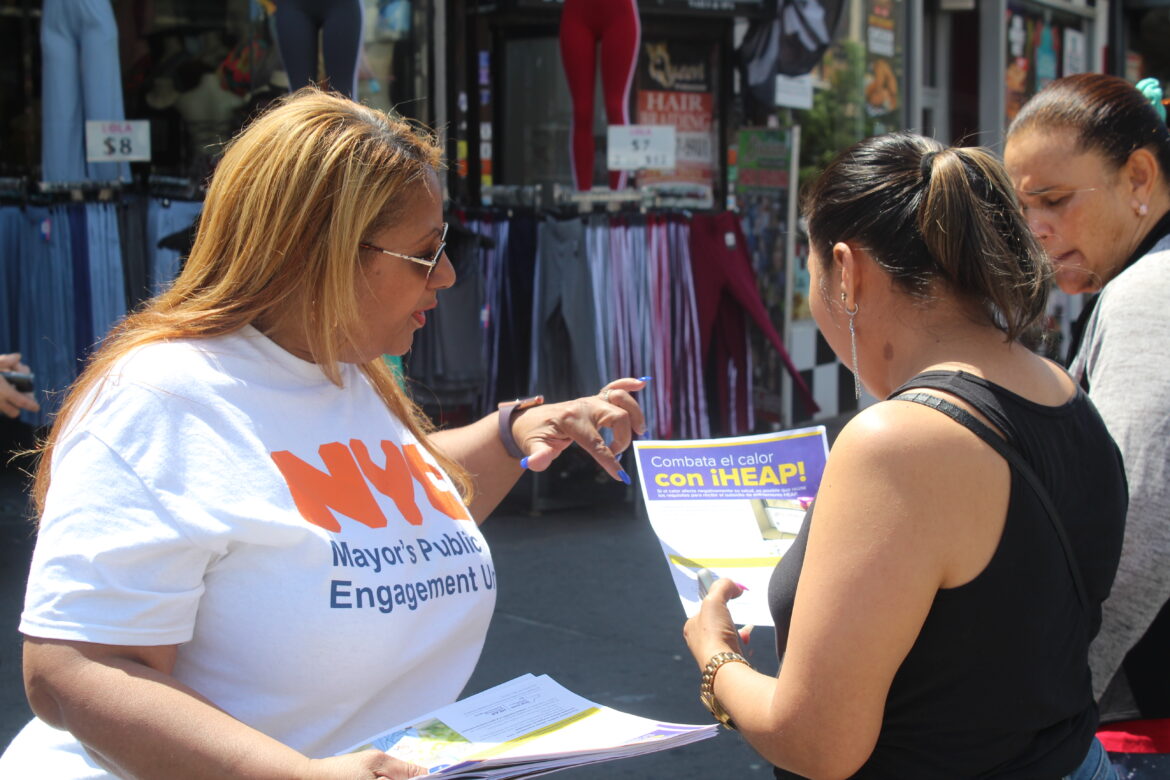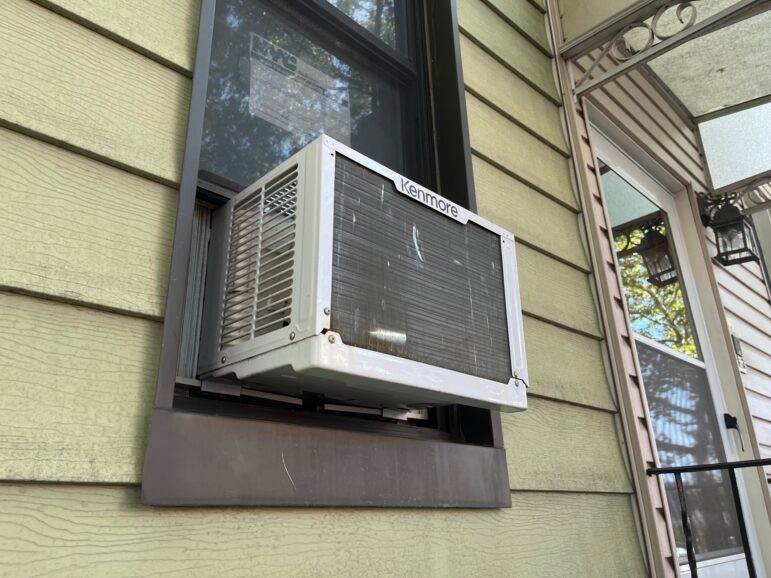The Home Energy Assistance Program (HEAP)’s cooling assistance benefit has helped tens of thousands of low-income New Yorkers beat the heat. But experts and advocates say it could do more, criticizing its limited reach—funding has run out by mid- to late-July the last two summers—and failure to grant complementary utility bill assistance.

NYC Mayor’s Public Engagement Unit
City staffers with the Mayor’s Public Engagement Unit handing out fliers about the HEAP cooling assistance benefit in the South Bronx on May 31, 2024.Lea la versión en español aquí.
While last year’s temperatures were among the highest on record for New York City, another red-hot summer is in the cards for 2024: the season’s first heat wave is expected to hit this week, officials warned.
The Home Energy Assistance Program (HEAP)’s cooling assistance benefit has been key to helping tens of thousands of New Yorkers combat the heat. The federally-funded initiative, operated by the New York State Office of Temporary and Disability Assistance (OTDA), helps low-income people purchase and install a fan or air conditioner at a cost of up to $1,000.
But experts and advocates say it could do more. They’ve criticized the program’s limited reach—funding has run out by mid– to late-July the last two summers—and its failure to grant complementary utility bill assistance. They say it may be struggling to keep up with the increasingly urgent needs of some of the most vulnerable, like seniors.
New York City residents can see if they qualify for HEAP’s cooling assistance benefit here.
A number of external factors are putting older adults at greater risk of suffering from the impending hot weather, including an increased poverty rate and skyrocketing residential utility bills, according to sources who spoke to City Limits. Across New York City, 68 people died from heat stress between 2012 and 2021, with residents over 60 facing the highest death rate.
“Older adults are the number one most impacted demographic for climate change,” said Kevin J. Kiprovski, director of public policy at LiveOnNY. “Internationally, during a heat emergency, 90 percent of the people who die are over 65.”
HEAP’s Cooling Assistance is estimated to have reached nearly 67,000 households over the past five years, according to OTDA. This year’s budget for the benefit is counted at $22 million—up from $17 million last summer, when 21,000 households benefited before the fund was exhausted on July 14.
HEAP will be accepting applications for this year through Friday, Aug. 30, or until funding runs out. New Yorkers must meet certain criteria, including income limits—one person can earn no more than $3,035 per month, unless they receive other public benefits—and must have a member of their household who is younger than 6, older than 60, or with a medical condition exacerbated by heat, among other requirements.
Kim Lerner, the director of the benefits outreach program at LiveOnNY, has helped hundreds of seniors apply for cooling assistance.
“I made a home visit for somebody who was suffering with breast cancer, and when I went into her apartment, I could not believe how stuffy and hot it was,” Lerner recalled. “I don’t know how she was dealing with it. And the only way she could get an air conditioner was through HEAP.”
Lerner commended the program for its improvements over the years, such as cutting the requirement of submitting medical paperwork, which was tedious and often a deterrent for applicants. However, while HEAP offers utility bill assistance for heating during the cold winter months, it doesn’t do so for cooling in the summer.
Lerner stated that many clients who received air conditioners through the program expressed a fear of running up utility bills, and said that subsidizing the cost would be a major help to them.
Her clients’ concerns are not unfounded: Residential utility bills are increasing due to higher summer temperatures and the prevalence of extreme heat events in recent years. Where keeping cool for the summer used to cost $476 in 2014, projections sit around $719 for 2024, according to a report from the National Energy Assistance Directors Association and the Center for Energy, Poverty and Climate.
And seniors’ pockets aren’t keeping up with those costs. Beth Finkel,* state director for AARP New York, said that the poverty rate among people over 65 in New York State went up over 35 percent in the last census.

Jeanmarie Evelly
The state-run Cooling Assistance Benefit provides eligible New Yorkers with up to $1,000 for the purchase and installation of an air conditioner.“Paying for an air conditioner or a fan with the installation of it, that can really break a household budget for somebody who’s living just at the poverty line or even a little above it,” Finkel told City Limits.
“The government needs to look at every avenue they can to help people,” Finkel added, when asked about the limitations of the cooling assistance program budget. “It’s a preventative health measure to make sure that people have a cooling system.”
Data from OTDA shows that over the past five years, cooling assistance accounted for just under two percent of the HEAP budget. Far more money is allocated to heating assistance throughout the colder months of the year, roughly 75 percent of the overall budget.
The disparity appears to be a counterintuitive approach, given the fact that there are higher rates of mortality for heat compared to any other weather-related cause.
“Funding for HEAP is determined in the federal budget and distributed to states via a formula,” a spokesperson for OTDA told City Limits in a statement. “While the federal government does not mandate states to operate a cooling program, New York State is one of several states that allocate a portion of its funding annually for this purpose, which New York has done for many years.”
OTDA has also extended HEAP’s emergency benefit component this year through the end of August, or until funding runs out, the spokesperson noted. Eligible households facing higher electric bills thanks to use of AC and other cooling equipment, and who’ve received a termination notice from their utility company, can apply for the emergency aid to avoid a shut off or to maintain service for at least another month.
“As climate change worsens, we are definitely seeing that hot weather, and not even extreme hot weather, even as low as 82 degrees is when we start seeing an uptick in heat related deaths among New Yorkers,” said Victoria Sanders, climate and health program manager at NYC Environmental Justice Alliance. “And so we definitely need to adjust our priorities as the realities of our world change.”
As a result of limited funding, HEAP announced the closure of cooling assistance applications barely midway through the summer of 2023, on July 14. The same thing could happen this year, even with proposed city budget cuts to senior centers on the horizon—many of which double as cooling centers for those who need the relief.
Sanders is named among the authors of a new Environmental Justice Alliance report outlining policy recommendations on air quality and heat vulnerability disparities for low-income communities of color. She agreed that the cooling assistance program’s expansion would be a significant short-term solution to the adverse effects of climate change.
“A large amount of people who die from heat actually die in their own homes, because they can’t get cool,” she said. “So it’s important that we have that so that we can protect the vulnerable residents of the city. And in the meantime, we’re gonna keep pushing the government to do a better job of combating climate change at the systemic level.”
*An earlier version of this story incorrectly identified Finkel’s last name. City Limits regrets the error.
To reach the reporter behind this story, contact Anastasia@citylimits.flywheelstaging.com. To reach the editor, contact Jeanmarie@citylimits.flywheelstaging.com
Want to republish this story? Find City Limits’ reprint policy here.








